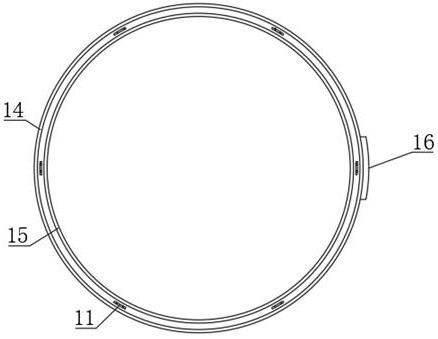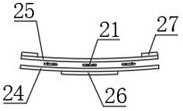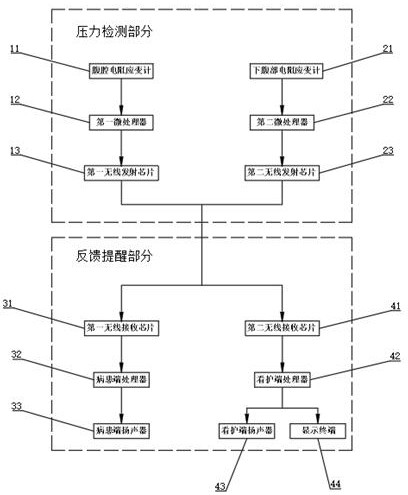Urine prompting device for children with special needs
A technique for urinating children, which is applied in instruments, alarms, urinary function evaluation, etc., can solve the problems of exacerbating the pain of patients, and achieve the effect of reducing pain and reducing detection errors
- Summary
- Abstract
- Description
- Claims
- Application Information
AI Technical Summary
Problems solved by technology
Method used
Image
Examples
Embodiment 1
[0029] Figure 1-Figure 3 Shown: a urination reminder device for children with special needs, including an abdominal cavity pressure detection group, a lower abdominal pressure detection group, a patient reminder module and a care-side reminder module.
[0030] The abdominal cavity pressure detection group is arranged on the outside of the patient's abdomen and is used to detect the abdominal cavity pressure of the patient. The abdominal cavity pressure detection group includes the abdominal cavity resistance strain gauge 11, the outer ring belt 14, the inner ring belt 15 and the abdominal cavity pressure signal processing module 16. The waist belt 14 and the inner ring waist belt 15 are connected together by bonding, and the abdominal cavity resistance strain gauges 11 are evenly arranged therebetween.
[0031] The lower abdominal pressure detection group is arranged on the skin of the patient's lower abdomen to detect the patient's bladder pressure. The pressure skin 25, th...
Embodiment 2
[0039] The difference between this embodiment and Embodiment 1 is that the abdominal cavity pressure signal processing module 16 includes a first microprocessor 12 and a first wireless transmitting chip 13, an abdominal cavity resistance strain gauge 11, a first microprocessor 12 and a first wireless The transmitting chips 13 are all electrically connected, and the first microprocessor 12 is used to process the signals collected by the abdominal cavity resistance strain gauge 11 and transmit the signals to the first wireless receiving module and the second wireless receiving module through the first wireless transmitting chip 13 .
Embodiment 3
[0041] The difference between this embodiment and Embodiment 2 is that the bladder pressure signal processing module 26 includes a second microprocessor 22 and a second wireless transmitting chip 23, a lower abdominal resistance strain gauge 21, a second microprocessor 22 and a second The wireless transmitting chips 23 are all electrically connected, and the second microprocessor 22 is used to process the signals collected by the lower abdominal resistance strain gauge 21, and transmit the signals to the first wireless receiving module and the second wireless through the second wireless transmitting chip 23. receive module.
PUM
 Login to View More
Login to View More Abstract
Description
Claims
Application Information
 Login to View More
Login to View More - R&D
- Intellectual Property
- Life Sciences
- Materials
- Tech Scout
- Unparalleled Data Quality
- Higher Quality Content
- 60% Fewer Hallucinations
Browse by: Latest US Patents, China's latest patents, Technical Efficacy Thesaurus, Application Domain, Technology Topic, Popular Technical Reports.
© 2025 PatSnap. All rights reserved.Legal|Privacy policy|Modern Slavery Act Transparency Statement|Sitemap|About US| Contact US: help@patsnap.com



